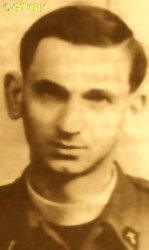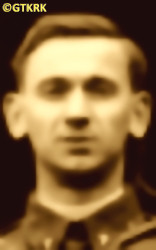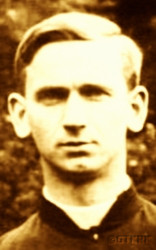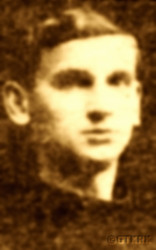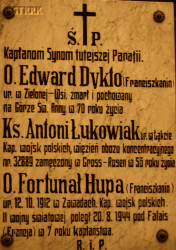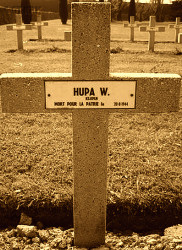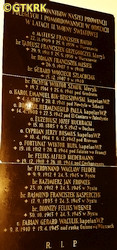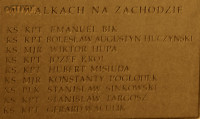Roman Catholic
St Sigismund parish
05-507 Słomczyn
85 Wiślana Str.
Konstancin deanery
Warsaw archdiocese, Poland
full list:
displayClick to display full list

searchClick to search full list by categories
wyświetlKliknij by wyświetlić pełną listę po polsku

szukajKliknij by przeszukać listę wg kategorii po polsku

Martyrology of the clergy — Poland
XX century (1914 – 1989)
personal data
surname
HUPA
forename(s)
Victor (pl. Wiktor)
religious forename(s)
Fortunate (pl. Fortunat)
function
religious cleric
creed
Latin (Roman Catholic) Church RCmore on
en.wikipedia.org
[access: 2014.09.21]
congregation
Order of Friars Minor OFMmore on
en.wikipedia.org
[access: 2013.05.19]
(i.e. Franciscans, Minorites)
diocese / province
Assumption into Heaven of the Blessed Mary province OFMmore on
pl.wikipedia.org
[access: 2014.08.14]
RC Military Ordinariate of Polandmore on
en.wikipedia.org
[access: 2014.12.20]
honorary titles
War Order of Virtuti Militari — Silver (5th Class)more on
War Order of Virtuti Militari – Silver (5th Class)
(29.09.1944, posthumously, by decision of the Commander—in—Chief of the Polish Armed Forces, General Casimir Sosnkowski)
date and place
of death
20.08.1944

Mont Ormelby Falaise
today: Orne dep., Normandie reg., France
more on
en.wikipedia.org
[access: 2023.03.16]
details of death
After German and Russian invasion of Poland in 09.1939 and start of the World War II, after German invasion of Belgium on 10.05.1940, five days later on 15.05.1940 crossed over from Belgium to France.
On 14.06.1940 was admitted to the Polish Army forming in France — after defeat in defense war of 09.1939 in Poland — and sent to officer school in Coetquidan n. Guer in Brittany, led by Gen. Stanislav Maczek (according to some sources arrived there already in 12.1939).
Drafted as senior chaplain, in Mayor rank.
As a result of fall of France crossed over English Channel on 19‐22.06.1940 from La Rochelle on Biscay Bay to Plymouth in UK.
Next in Scotland — chaplain in the Polish Armed Forces, in 1st Reconnaissance Regiment of the 1st Grenadier Division, among others.
During the Allied preparations for the invasion of Normandy, on 08.02.1944 became chaplain of the 3rd Riflemen Brigade of the 1st Panzer Division led by Gen. Maczek, serving in 9th Flanders Riflemen Regiment.
Perished during invasion of Normandy, at Falaise operation, in a battle known as battle of Mont Ormel — during the German counterattacks on the hill „Mace” (hill No. 262) — when ministering to the wounded.
Himself slightly wounded, with a wooden cross in one hand and Red Cross flag in another, marched towards nearby sanitary cars — despite this was shot by Germans with a machine gun fire.
His comrades–in–arms testified: „While constantly on the combat scene, Chaplain Fr Victor Hupa helped wounded soldiers, lifted the spirits of those fighting, and with his wonderful attitude set a personal example of courage and selfless work […] When the soldiers warned him not to go because an enemy artillery barrage was approaching, he, holding a cross in his hand, had only one answer: my wounded soldiers are there, I have to be there”.
cause of death
warfare
perpetrators
Germans
sites and events
Ribbentrop‐MolotovClick to display the description, Pius XI's encyclicalsClick to display the description
date and place
of birth
19.10.1912

Zawadytoday: Rawicz gm., Rawicz pov., Greater Poland voiv., Poland
more on
en.wikipedia.org
[access: 2021.12.18]
religious vows
28.09.1931 (temporary)
28.09.1934 (permanent)
presbyter (holy orders)
ordination
26.09.1937

Wronkitoday: Wronki gm., Szamotuły pov., Greater Poland voiv., Poland
more on
en.wikipedia.org
[access: 2021.06.20]
positions held
1940 – 1944
RC senior military chaplain — Polish Armed Forces (formed „in the West”), Polish Armed Forces — from 08.02.1944 chaplain of the 3rd Armoured Rifle Brigade, within the 1st Armoured Division of Gen. Stanislav Maczek, assigned to the 9th Flemish Rifle Battalion; from c. 1940 chaplain of the 1st Reconnaissance Regiment of the 1st Grenadier Division stationed in Scotland; 1940 chaplain of the officer cadet school in Coetquidan near Guer in Brittany, France
1938 – 1940
student — Louvaintoday: Flemish Brabant prov., Flemish reg., Belgium
more on
en.wikipedia.org
[access: 2020.11.07] ⋄ Church history, Université Catholique de Louvain (pl. Catholic University of Leuven) — in‐depth studies
1934 – 1938
student — Wronkitoday: Wronki gm., Szamotuły pov., Greater Poland voiv., Poland
more on
en.wikipedia.org
[access: 2021.06.20] ⋄ Theological Study (higher theological seminary), Annunciation to the Blessed Virgin Mary monastery, Franciscans OFM
1931 – 1934
student — Osiecznatoday: Osieczna gm., Leszno pov., Greater Poland voiv., Poland
more on
en.wikipedia.org
[access: 2021.07.18] ⋄ Philosophical Study (higher theological seminary), St Valentine Priest and Martyr monastery, Franciscans OFM — also: supplementing secondary education
25.09.1930 – 28.09.1931
novitiate — Wieluńtoday: Wieluń gm., Wieluń pov., Łódź voiv., Poland
more on
en.wikipedia.org
[access: 2021.07.18] ⋄ Annunciation to the Blessed Virgin Mary monastery, Franciscans OFM
till 1930
pupil — Rybniktoday: Rybnik city pov., Silesia voiv., Poland
more on
en.wikipedia.org
[access: 2021.08.12] ⋄ Minor Theological Seminary (Seraphic College), Franciscans OFM
others related
in death
BIKClick to display biography Emanuel (Fr Charles), BORYŃSKIClick to display biography Henry, KRÓLClick to display biography Joseph, MISIUDAClick to display biography Hubert Victor, POGŁÓDEKClick to display biography Constantine, TARGOSZClick to display biography Stanislav Peter
sites and events
descriptions
Ribbentrop‐Molotov: Genocidal Russian‐German alliance pact between Russian leader Joseph Stalin and German leader Adolf Hitler signed on 23.08.1939 in Moscow by respective foreign ministers, Mr. Vyacheslav Molotov for Russia and Joachim von Ribbentrop for Germany. The pact sanctioned and was the direct cause of joint Russian and German invasion of Poland and the outbreak of the World War II in 09.1939. In a political sense, the pact was an attempt to restore the status quo ante before 1914, with one exception, namely the „commercial” exchange of the so‐called „Kingdom of Poland”, which in 1914 was part of the Russian Empire, fore Eastern Galicia (today's western Ukraine), in 1914 belonging to the Austro‐Hungarian Empire. Galicia, including Lviv, was to be taken over by the Russians, the „Kingdom of Poland” — under the name of the General Governorate — Germany. The resultant „war was one of the greatest calamities and dramas of humanity in history, for two atheistic and anti‐Christian ideologies — national and international socialism — rejected God and His fifth Decalogue commandment: Thou shall not kill!” (Abp Stanislav Gądecki, 01.09.2019). The decisions taken — backed up by the betrayal of the formal allies of Poland, France and Germany, which on 12.09.1939, at a joint conference in Abbeville, decided not to provide aid to attacked Poland and not to take military action against Germany (a clear breach of treaty obligations with Poland) — were on 28.09.1939 slightly altered and made more precise when a treaty on „German‐Russian boundaries and friendship” was agreed by the same murderous signatories. One of its findings was establishment of spheres of influence in Central and Eastern Europe and in consequence IV partition of Poland. In one of its secret annexes agreed, that: „the Signatories will not tolerate on its respective territories any Polish propaganda that affects the territory of the other Side. On their respective territories they will suppress all such propaganda and inform each other of the measures taken to accomplish it”. The agreements resulted in a series of meeting between two genocidal organization representing both sides — German Gestapo and Russian NKVD when coordination of efforts to exterminate Polish intelligentsia and Polish leading classes (in Germany called «Intelligenzaktion», in Russia took the form of Katyń massacres) where discussed. Resulted in deaths of hundreds of thousands of Polish intelligentsia, including thousands of priests presented here, and tens of millions of ordinary people,. The results of this Russian‐German pact lasted till 1989 and are still in evidence even today. (more on: en.wikipedia.orgClick to attempt to display webpage
[access: 2015.09.30])
Pius XI's encyclicals: Facing the creation of two totalitarian systems in Europe, which seemed to compete with each other, though there were more similarities than contradictions between them, Pope Pius XI issued in 03.1937 (within 5 days) two encyclicals. In the „Mit brennender Sorge” (Eng. „With Burning Concern”) published on 14.03.1938, condemned the national socialism prevailing in Germany. The Pope wrote: „Whoever, following the old Germanic‐pre‐Christian beliefs, puts various impersonal fate in the place of a personal God, denies the wisdom of God and Providence […], whoever exalts earthly values: race or nation, or state, or state system, representatives of state power or other fundamental values of human society, […] and makes them the highest standard of all values, including religious ones, and idolizes them, this one […] is far from true faith in God and from a worldview corresponding to such faith”. On 19.03.1937, published „Divini Redemptoris” (Eng. „Divine Redeemer”), in which criticized Russian communism, dialectical materialism and the class struggle theory. The Pope wrote: „Communism deprives man of freedom, and therefore the spiritual basis of all life norms. It deprives the human person of all his dignity and any moral support with which he could resist the onslaught of blind passions […] This is the new gospel that Bolshevik and godless communism preaches as a message of salvation and redemption of humanity”… Pius XI demanded that the established human law be subjected to the natural law of God , recommended the implementation of the ideal of a Christian state and society, and called on Catholics to resist. Two years later, National Socialist Germany and Communist Russia came together and started World War II. (more on: www.vatican.vaClick to attempt to display webpage
[access: 2023.05.28], www.vatican.vaClick to attempt to display webpage
[access: 2023.05.28])
sources
personal:
www.encyklo.plClick to attempt to display webpage
[access: 2021.12.19], www.sacerdospolonus.plClick to attempt to display webpage
[access: 2014.08.14], prowincja.panewniki.plClick to attempt to display webpage
[access: 2018.09.02]
original images:
www.polishwargraves.nlClick to attempt to display webpage
[access: 2020.05.25], repozytorium.kul.plClick to attempt to display webpage
[access: 2024.12.13], prowincja.panewniki.plClick to attempt to display webpage
[access: 2018.09.02], prowincja.panewniki.plClick to attempt to display webpage
[access: 2018.09.02], prowincja.panewniki.plClick to attempt to display webpage
[access: 2018.09.02], www.polskaniezwykla.plClick to attempt to display webpage
[access: 2014.01.06], www.panewniki.franciszkanie.plClick to attempt to display webpage
[access: 2013.12.27], www.katedrapolowa.plClick to attempt to display webpage
[access: 2014.01.16]
LETTER to CUSTODIAN/ADMINISTRATOR
If you have an Email client on your communicator/computer — such as Mozilla Thunderbird, Windows Mail or Microsoft Outlook, described at WikipediaPatrz:
en.wikipedia.org, among others — try the link below, please:
LETTER to CUSTODIAN/ADMINISTRATORClick and try to call your own Email client
If however you do not run such a client or the above link is not active please send an email to the Custodian/Administrator using your account — in your customary email/correspondence engine — at the following address:

giving the following as the subject:
MARTYROLOGY: HUPA Victor
To return to the biography press below:
 Click to return to biography
Click to return to biography








